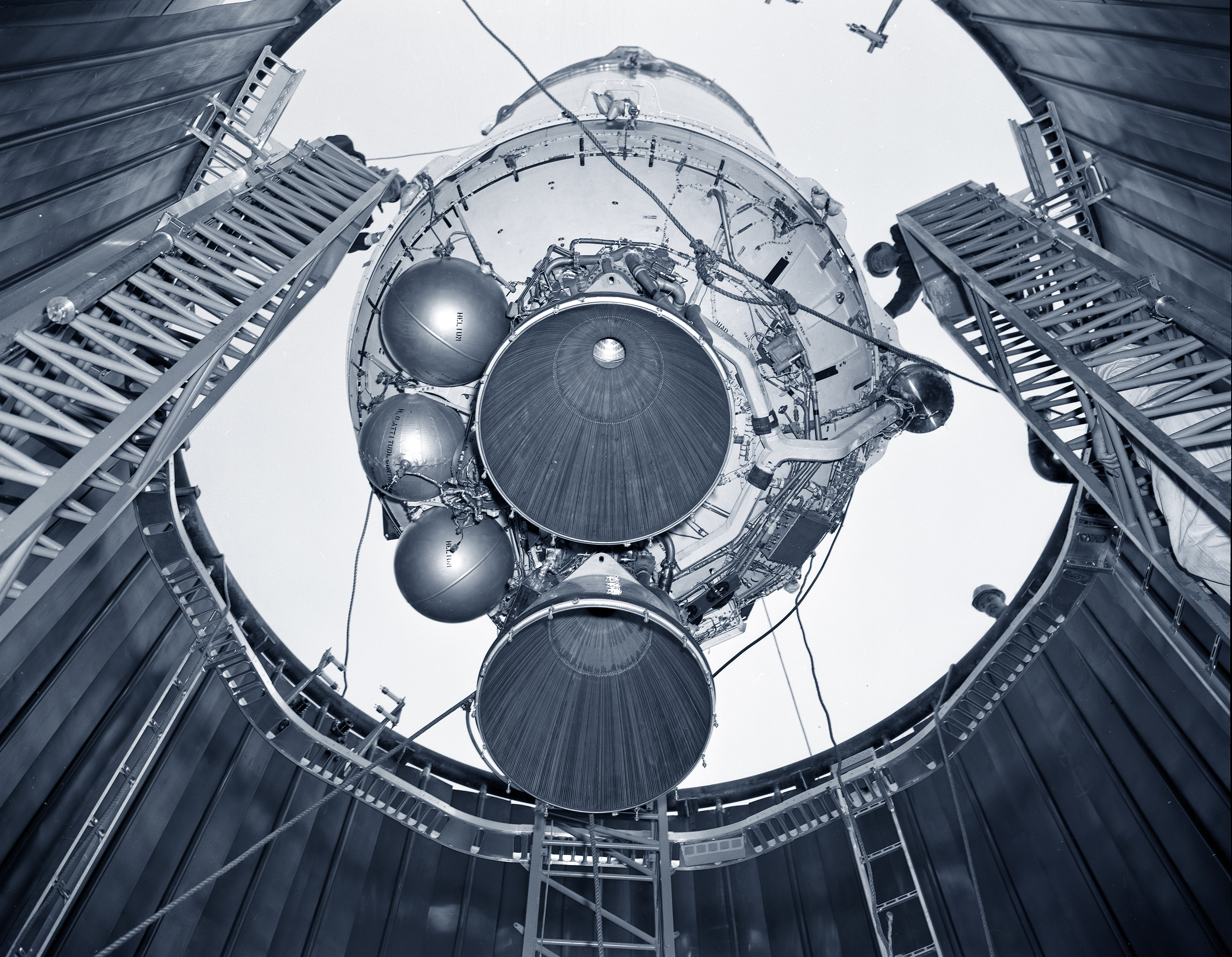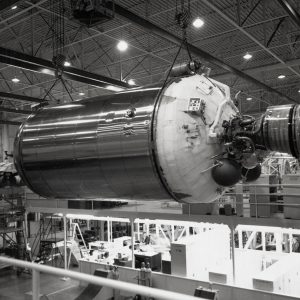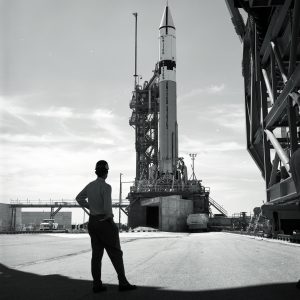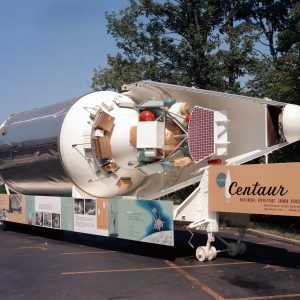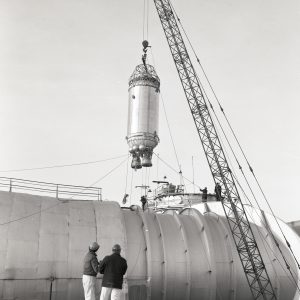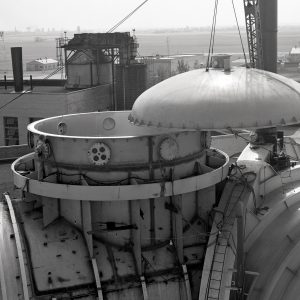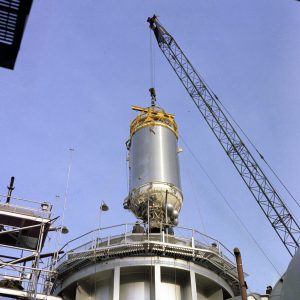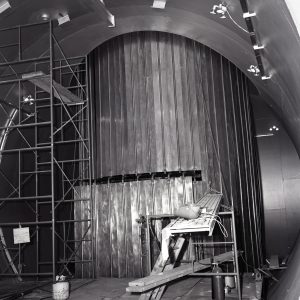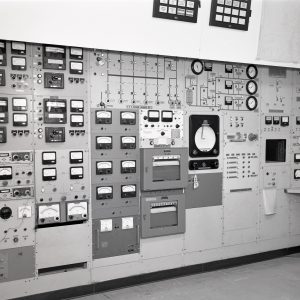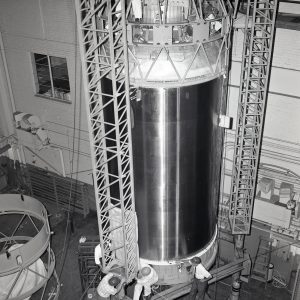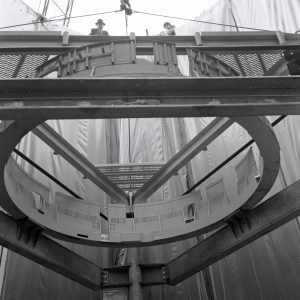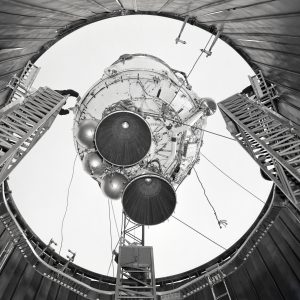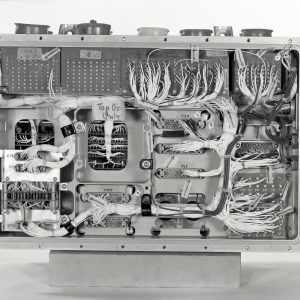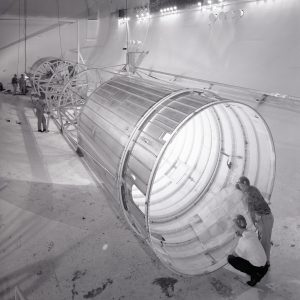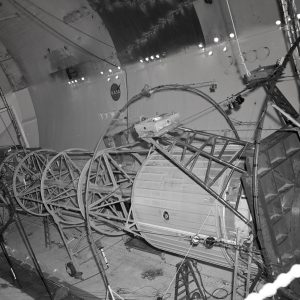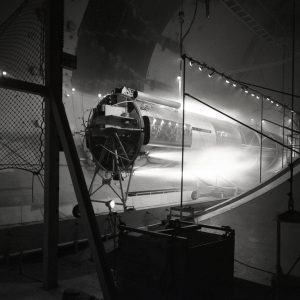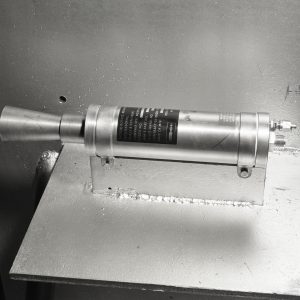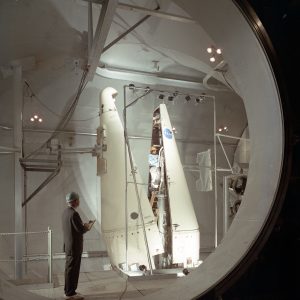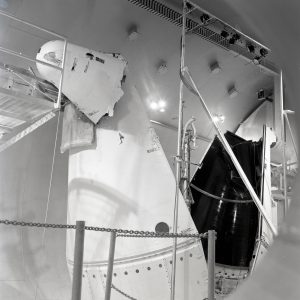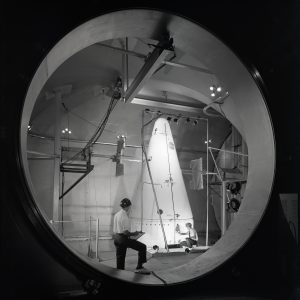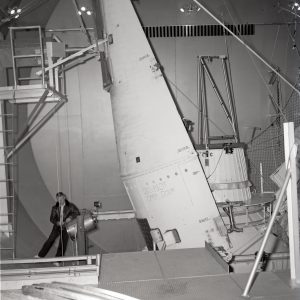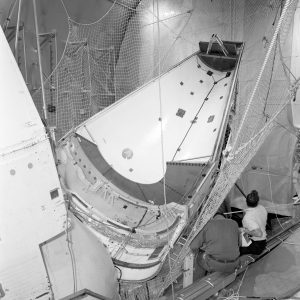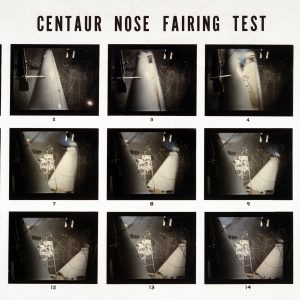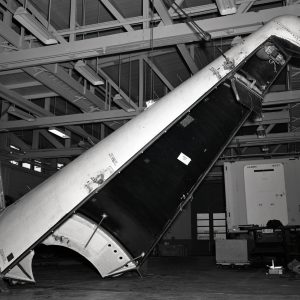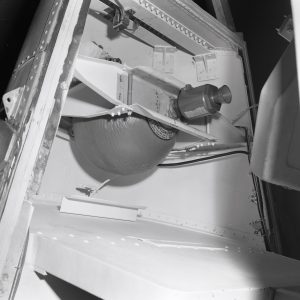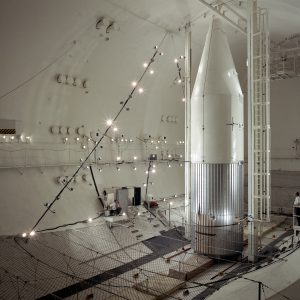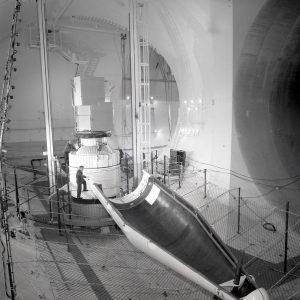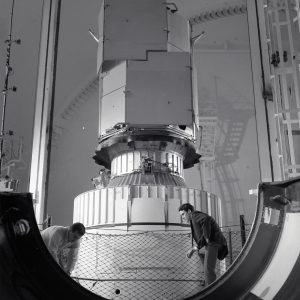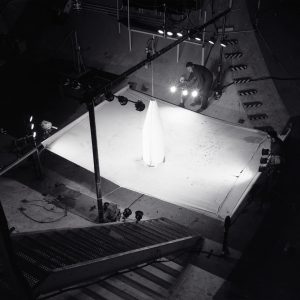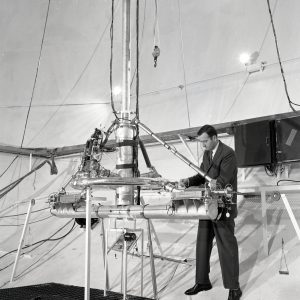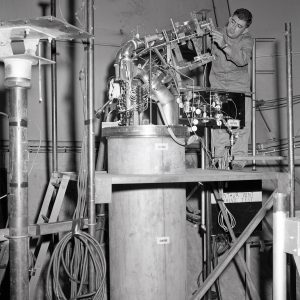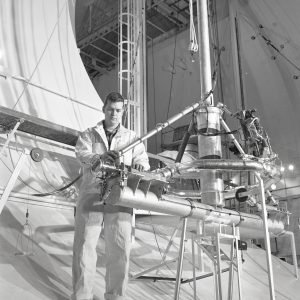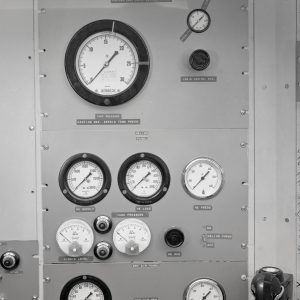SPC Centaur Testing | Glenn Research Center | NASA (original) (raw)
A Centaur 6A rocket is lowered into SPC No.1 to test its auxiliary propulsion, hydraulic, pneumatic, and electrical systems in a simulated space environment (3/19/1964).
In the early 1960s, NASA decided to use it new SPC test chambers for a variety of tests of the Centaur upper stage rocket. These included tests of its retrorockets, electronics systems, shroud jettison system, and fuel tank ventilation.
Overview
General Dynamics began developing the Centaur rocket for the military in 1958. The vehicle was unique in several aspects, particularly its use of Pratt & Whitney’s new liquid hydrogen-fueled RL–10 engines. The Marshall Space Flight Center took over responsibility for Centaur in late 1959, as NASA decided it needed hydrogen upper stages for its coming missions. On May 8, 1962, the first attempt to launch a Centaur with an Atlas missile failed. Marshall had never felt comfortable with Centaur’s non-traditional design, and the program was on the verge of cancellation. NASA, which was by then relying on Centaur to send Surveyor spacecraft to the Moon, transferred the program to the Lewis Research Center in October 1962.
Lewis undertook an extensive effort to test and improve Centaur. The primary Centaur testing was divided between the dynamic and vibration studies of the Atlas/Centaur at Plum Brook Station [today, the Neil Armstrong Test Facility] and environmental and shroud jettison tests in the new Space Power Chambers (SPC). Researchers used the SPC No. 1 vacuum tank to verify the performance of Centaur’s electronics systems in a simulated space environment and test the shroud jettison system to be used on the Surveyor launches. The larger chamber, SPC No. 2, was used to test the retrorockets which separated the Centaur from the Atlas during launch. Engineers also used SPC No. 2 test shroud jettison systems for larger Centaur payloads in the late 1960s.
The second Atlas/Centaur launch attempt in November 1963 was a success. Centaur not only made the Surveyor program a success but would go on to perform over 175 missions with only a handful of failures. These missions included Pioneer, Viking, the Lunar Orbiter, Orbiting Astronomical Observatories, Cassini, and others.
Documents
- Taming Liquid Hydrogen: the Centaur Upper Stage Rocket, 1958-2002
- Centaur First in Space with Liquid Hydrogen (1962)
- Centaur Press Releases
A Centaur second-stage rocket being assembled and readied at a General Dynamics factory for launch (11/8/1962).
Tanking test of the Atlas-Centaur 3 vehicle prior to its June 30, 1964 launch attempt.
Lewis created this full-scale model of the Centaur stage with its Surveyor spacecraft in September 1964.
A Centaur 6A rocket is lowered through opened dome into the SPC No. 1 for a series of environmental tests (3/14/1964).
Systems Testing
NASA originally envisioned using SPC No. 1’s vacuum tank to test space power devices like the SNAP–8 nuclear generator. With the acquisition of the Centaur Program, however, Lewis decided to use the tank to study the electronics behavior a full-scale Centaur in a space environment. SPC No. 1 underwent several modifications to accommodate Centaur. The most prominent of which was the addition of a 22.5-foot-diameter cylindrical extension with a detachable dome so that the rocket could be stood up vertically.
In October 1963 a Centaur 6A rocket was flown to Cleveland on a C-130 aircraft. General Dynamics personnel worked for months with Lewis engineers in the SPC’s shop area to prepare the rocket for the tests. On March 19, 1964, a 100-foot-tall crane lowered the Centaur through SPC No. 1’s opened dome and onto a test stand. The chamber (described here) could simulate virtually every facet of the space environment.
A 100 foot crane was used to remove the 22.5 foot diameter dome from the SPC so a Centaur rocket could be lowered into the chamber (8/7/1963).
A 100-foot crane lowers a Centaur 6A into the SPC No. 1 for a series of systems tests in a simulated space environment (3/19/1964).
A 42-foot tall copper liquid nitrogen-cooled baffle was erected around the Centaur set-up to simulate the cryogenic temperatures of outer space (1963).
These panels in the SPC No. 1 control room monitored the Centaur 6A rocket undergoing a series of systems tests inside the chamber (1/6/1967).
Centaur possessed a number of systems including autopilot, guidance, main propulsion, hydraulic, hydrogen peroxide supply, boost-pump attitude control, telemetry, tracking, range safety, and pneumatic systems. Early space flights had demonstrated that these systems behaved differently in space than in an Earth environment. Lewis researchers used SPC No. 1 to subject the Centaur to an entire simulated flight, with the exception of firing the engines. The initial three-minute Atlas booster phase was followed by the activation of the Centaur stage separation systems. Simulated engine firing was followed by a 25-minute coast phase. A second engine activation and payload separation were then simulated, followed by a course reversal and systems final shutdown.
After a series of tests involving the configuration for the Atlas/Centaur-4 launch, technicians upgraded the stage’s electronics to match the design for the upcoming Atlas/Centaur-8 design. Over the span of several years, the researchers subjected the Centaur to 20 to 30 simulated missions to verify the vehicle’s basic reliability during long durations in space. The tests revealed that the canisters that housed the electronics must be unpressurized and that the minimization of the necessary power levels reduced overheating.
Documents
- SPC Operation Overview (2009)
- Space Simulation in a Converted Facility (1966)
- Flight Simulation Tests of a Centaur Vehicle (1970)
- Centaur Inverter Failure During SPC Test (1967)
- Centaur SPC Testing articles (1964)
Preparation of a Centaur rocket in the SPC shop area prior to insertion into the vacuum chamber for environmental systems testing (10/9/1963).
The Centaur rested on this approximately 9-foot tall triangular stand inside SPC No. 1 (1/16/1964).
Installation of Centaur vehicle into SPC No. 1, which could simulate the vacuum at an altitude of about 100 miles (3/19/1964).
Auxiliary electronics box for the Centaur stage (1965).
Atlas-Centaur Retrorockets
The first tests in the SPC were a series of Atlas/Centaur separation tests which began in the fall of 1963. The performance of the retrorockets that separated the Centaur stage from the Atlas booster was inconsistent. Lewis engineers hung a model of the Atlas/Centaur vehicle horizontally on a trolley system inside SPC No. 2 altitude chamber (facility description). The model simulated the mass properties of a full-size Atlas/Centaur without using the actual vehicles.
The initial tests, conducted at simulated altitudes of 98,000 feet, verified the poor performance of the Rocket Power, Inc. retrorockets. The researchers placed foam panels placed behind the retrorockets to record the flame disbursement. They determined that the unpredictable firing was due to poor manufacturing processes.
Rocket Power, Inc. used the results to create a new lighter which produced a longer flame to light the propellant grain. Researchers retested the Atlas/Centaur configuration with the new lighters in spring of 1964. The SPC No. 2 testing showed that improved retrorockets performed well at 100,000 feet. The researchers were also able to configure the retrorockets in such a way that failure of one thruster would not cause a mission failure. These changes fundamentally altered the separation system.
Documents
- Atlas Solid Fuel Rocket Separation Test (1965)
- Separation Dynamics of Atlas-Centaur (1967)
- Improved Ignitor for Atlas-Centaur Separation (1968)
Installation of an apparatus designed to simulate the size and weight of an Atlas/Centaur rocket package inside SPC No. 2 (81/1963).
Lewis personnel prepare an apparatus designed to simulate the size and weight of an Atlas/Centaur rocket package for separation testing (9/27/1963).
High-speed photograph of a separation test in SPC No. 2 that used a unique model that simulated the Atlas/Centaur’s size and weight (2/27/1964).
An Atlas/Centaur retrorocket which failed during testing in the SPC No. 2. The thruster was redesigned and successfully retested (1963).
Surveyor Shroud Separation
The third Atlas/Centaur launch in June 1964 almost failed when an error during the shroud separation caused a brief disruption of the guidance system. General Dynamics had tested the nose cone repeatedly in ambient conditions, but it was becoming apparent that space flight hardware behaved differently in a space environment. The fourth launch attempt, Atlas/Centaur-4, was intended to insert a mockup Surveyor spacecraft in orbit, and there was tremendous pressure to keep the program on schedule.
NASA decided to test the shroud separation system in the SPC No. 1 vacuum chamber. The shroud was mounted on a platform. Hinges fixed the lower end to the platform, and catcher pads captured the jettisoned faring halves. The tips of the faring halves broke off during the first test. The team obtained a new shroud and redesigned its internal bulkhead. They also replaced one of the catchers with a net and moved the setup away from the Centaur rocket that was also in the chamber. The tests, which continued into the fall of 1964, determined that new separation devices could successfully jettison the fairing without damaging the payload. All modifications implemented between the third and fourth Centaur missions were verified in the SPC. The December 11, 1964, Atlas/Centaur-4 launch was the first Centaur mission to have an error-free shroud jettison.
Test setup prior to the first run on July 31, 1964 which would be a successful dry run at atmospheric pressure to check the setup and instrumentation.
During a Surveyor faring separation test in SPC No. 1, the deflector bulkheads were ripped from their bindings, and the shroud tips were broken off above the catcher pads. (8/5/1964)
Preparation for a series Surveyor nose faring tests in SPC No. 1. The faring halves jettisoned into catch nets (7/29/1964).
A Surveyor faring separation test in SPC No. 1 had a few minor errors—small damage to the barrel section, bending of a thermal bulkhead strut, and minor nose tip damage (10/30/1964).
After the spectacular launch pad explosion of the Atlas/Centaur-5 in March 1965, General Dynamics modified elements of the Centaur. The changes required a requalification of its nose cone in SPC No. 1 in the summer of 1965. The tests determined the shroud’s impact on the payload envelope and its effect on the new, thinner Centaur fuel tanks. Lewis researchers approved the entire nose fairing design and load limits for flight. Atlas/Centaur-6, launched from Cape Canaveral on August 11, 1965, successfully placed a Surveyor model into orbit. The success restored NASA’s confidence in the Centaur’s capabilities.
Documents
- Centaur AC-4 Nose Fairing Jettison (1966)
- Surveyor Nose Fairing Mode Survey (1964)
- Centaur AC-6 Nose Fairing Separation (1967)
Surveyor shroud half in catch net. The full-size Centaur stage was set up behind the hanging tarp in the background (1964).
High-speed photographs of Surveyor shroud jettison in SPC No. 1.
Preparation of Surveyor shroud for testing in SPC No. 1 (1965).
This thruster bottle and nozzle in the tip of the Surveyor nose cone. When fired this forced the two halves of the shroud to eject away from one another. (5/10/1965)
Testing of Larger Shrouds
NASA’s Goddard Space Flight Center designed the Orbiting Astronomical Observatory (OAO) satellites to study stars and galaxies which not visible to Earth-bound and atmospheric telescopes. The scientists hoped that the measurement of their ultraviolet radiation would help date stars. Ozone absorption and atmospheric filtering prevented the retrieval of this data from Earth. The OAO missions required large, stable platforms so that the telescopes could focus for long periods of time on dim objects. This made OAO–1 the heaviest payload to date carried by the Atlas/Agena-D launch vehicle. The OAO shrouds to launch these satellites were much larger than the Surveyor nose cones. Lewis used the SPC No. 2 chamber to test the shroud separation system for several OAO missions.
In the summer of 1965, Lewis engineers successfully qualified OAO–1 shroud’s separation system in SPC No. 2 at simulated altitudes of 20 miles. The shroud was set up vertically on a mockup Agena adapter with a large nylon net stretched horizontally 11 feet above the chamber floor to catch the faring section after the ejection. The April 9, 1966 launch was successful, but the OAO–1 satellite failed early in the mission.
OAO–2 would be launched on an Atlas/Centaur using a modified Agena shroud, which was 18 feet longer than the Surveyor shrouds. In April 1968, Lewis successfully qualified this new piece of hardware with three tests in SPC No. 2. For the first time, the researchers used x-rays to verify the payload clearance once the shroud was sealed. OAO–2, launched on December 7, 1968, became an extremely successful scientific mission.
The next OAO mission (OAO–B), however, failed on November 30, 1970, when one of 16 bolts securing the shroud did not release. Not long afterwards Lewis began using SPC No. 2 to conduct the failure investigation using a small-scale model of the shroud. Although they could not pinpoint a single cause of the failure, the studies led to a redesign of the shroud that condensed the two-step jettison process into a single motion. This new shroud was qualified in SPC No. 2 in the spring of 1972. This final OAO mission, launched on August 21, 1972, lasted for eight years and became the most successful of the OAO satellites.
Documents
- Centaur-OAO Nose Fairing Test (1970)
- Atlas-Centaur Flight Performance for OAO-II (1970)
- Technical Services Reviews of OAO Tests (1971-72)
- Atlas-Centaur Lifts OAO into Orbit article (1972)
Qualification of the shroud separation system for the OAO-1 in SPC No. 2. OAO-1 was the heaviest payload yet carried by the Atlas Agena D (1965).
Shroud jettison tests for the Orbiting Astronomical Observatory (OAO-2) in the SPC No. 2 were conducted in April 1968.
Lewis researchers examine the base of the OAO-2 nose fairing after it was jettisoned in SPC No. 2 (1/4/1968).
Researchers used a sub-scale model to conduct an investigation of the shroud separation system that failed OAO-2 launch (4/23/1971).
Hydrogen Tank Venting
The liquid-hydrogen propellant used by Centaur provided a very high thrust/weight ratio, but it also posed a number of technical difficulties. The tanks required vents because the cryogenic liquid-hydrogen vaporized at an extremely low temperature. Since Centaur missions often required multiple engine firings, it was necessary to stabilize the propellant in the tank so that it did not slosh when the first burn was completed. In addition, solar radiation caused the liquid-hydrogen to boil off in a gas form. These gases had to be vented from the tank. NASA designed the Atlas/Centaur–4 and Atlas/Centaur–8 missions to study the propellant’s behavior.
When the first engine burn ended on Atlas/Centaur–4, the liquid-hydrogen sloshed forward resulting in the venting of some of the hydrogen in liquid form rather than gas. This prevented the vehicle from maintaining its balance, which caused the spillage of nearly 90 percent of the remaining fluid. The engines could not be restarted for the second burn, and the mission ended.
A new balanced venting system was developed for the Atlas/Centaur–8 mission that expelled off-gasses in an even and non-propulsive manner. The system also included a baffle to prevent sloshing inside the tank. Between 1964 and 1966, Lewis engineers subjected the new even distribution system to extensive testing and qualification runs in SPC No. 2. The vent system was installed on a rig, which allowed the gaseous pressure to be pumped in and vented in a high-altitude environment. The May 30, 1966 Atlas/Centaur-8 mission was the first time the Centaur was able to successfully restart its engines in space.
Documents
- Management of Cryogenic Propellants in Vehicle (1968)
- Propellant Management System for Atlas-Centaur 8 (1966)
- Post-Flight Evaluation of Atlas-Centaur 8 (1967)
Tests of a new system to vent off-gasses evenly from the Centaur rocket’s liquid-hydrogen propellant tank (12/1/1965).
A technician installs a Centaur vent valve test rig in SPC No. 2 (7/13/1965).
Test in SPC No. 2 of a new balanced, non-propulsive vent system designed for Atlas/Centaur-8 (12/1/1965).
This panel controlled the vent valve system being tested in SPC No. 2 for the Centaur rocket’s liquid-hydrogen propellant tanks (1965).
